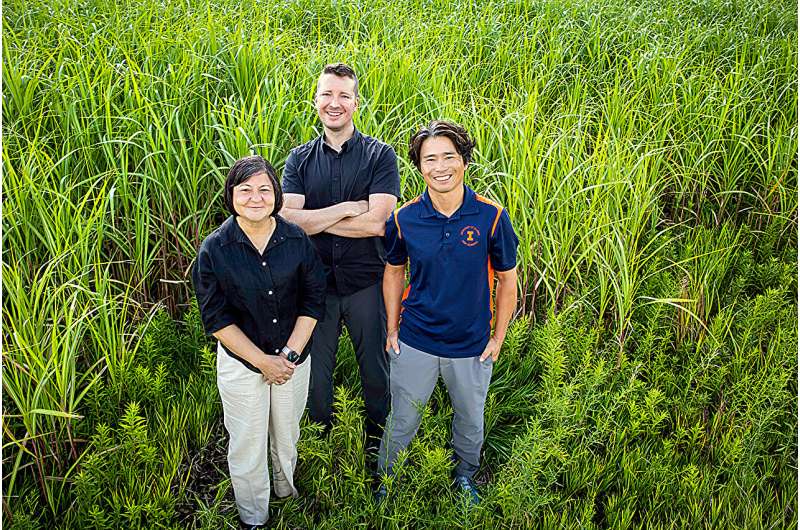This article has been reviewed according to Science X's editorial process and policies. Editors have highlighted the following attributes while ensuring the content's credibility:
fact-checked
peer-reviewed publication
trusted source
proofread
Study identifies best bioenergy crops for sustainable aviation fuels by US region, policy goals

Researchers analyzed the financial and environmental costs and benefits of four biofuels crops used to produce sustainable aviation fuels in the U.S. They found that each feedstock—corn stover, energy sorghum, miscanthus or switchgrass—performed best in a specific region of the rainfed United States.
Their study will help growers and policymakers select the feedstocks most suited to meeting goals like reducing production costs, lowering greenhouse gas emissions and building soil carbon stocks.
The U.S. currently consumes 23 billion gallons of jet fuel per year, and aviation fuel accounts for roughly 13% of domestic transportation carbon dioxide emissions, the researchers report in their analysis in the journal Environmental Science and Technology.
So far, only a few million gallons of sustainable aviation fuels are produced in the U.S., but a national initiative, the Sustainable Aviation Fuel Grand Challenge, aims to expand production to 3 billion gallons by 2030 and 35 billion gallons by 2050 while achieving a 50% reduction in life-cycle greenhouse gas emissions intensity compared with conventional fuel.
The mix of bioenergy crop feedstocks that will be produced to meet this challenge, their relative costs and carbon intensities will depend on how the goals of the policy are specified, said Madhu Khanna, a professor of agricultural and consumer economics at the University of Illinois Urbana-Champaign and the director of the U. of I. Institute for Sustainability, Energy and Environment. Khanna led the study with Xinxin Fan, a postdoctoral researcher at iSEE.
"It's a huge task to weigh all the factors that make a particular biofuels feedstock economically or environmentally viable," Khanna said. "You have to consider all other potential uses for the land used to grow the crop, the costs of establishing a new crop, and numerous other factors like weather, soil carbon and the productivity of a given crop in a particular location."
"There's also the cost of converting different feedstocks into biofuels and the greenhouse gas emissions associated with growing and transporting them to a refinery," Fan said.
The goal was to identify feedstocks with the lowest "break-even price" for a grower switching from another viable crop, the lowest carbon intensity and cost of carbon abatement, and the highest biomass produced per unit of land.
Identifying these factors for each feedstock and growing region will allow growers and policymakers to determine which crops will perform best in each part of the country and which policies or incentives will be most successful, Fan said.
The researchers divided the rainfed zones of their study area—encompassing most of the continental U.S. from the Dakotas, Nebraska, Kansas, Oklahoma and Texas eastward—into 1.5-mile-square plots. They focused on four zones: the Great Plains, Midwest, Northeast and Southeast.
The team first determined the break-even costs for a grower switching from the next most viable crop to a biofuels crop. These include outlays for seed, chemicals, fertilizing, storage and all other costs associated with planting, maintaining and harvesting a crop.
The scientists also modeled the different growing conditions; carbon emissions; and the costs and benefits across the life cycle of each feedstock, including hauling it to a biorefinery and converting it to useable jet fuel. They also determined the average cost of greenhouse-gas abatement per feedstock.
"We show that the optimal feedstock for each location differs depending on whether the incentive is to lower the break-even price, carbon intensity or cost of carbon abatement, or to have higher biomass production per unit of land," the researchers wrote.
The cost of abating greenhouse gas emissions with sustainable aviation fuels "was lowest with miscanthus in the Midwest, switchgrass in the South and energy sorghum in a relatively small region in the Great Plains," they reported. "While corn-stover-based SAF had the lowest break-even price per gallon, it has the highest cost of abatement due to its relatively high greenhouse gas intensity."
Different policies would favor some feedstocks over others, Khanna said. Corn stover would win out if policymakers prioritized the volume of production over the total reduction in greenhouse gas emissions. However, use of this feedstock would reduce soil carbon stores, making it more carbon-intensive than the other energy crops.
Miscanthus and switchgrass increase soil carbon and would do much more to lower greenhouse gas emissions than corn stover. But these feedstocks are more expensive to produce, requiring an incentive like a carbon tax credit to make them economically viable.
Ultimately, the researchers conclude, "Either carbon prices would need to rise or the cost of producing sustainable aviation fuels will need to fall to make SAFs an economically attractive alternative to jet fuel."
More information: Xinxin Fan et al, Spatially Varying Costs of GHG Abatement with Alternative Cellulosic Feedstocks for Sustainable Aviation Fuels, Environmental Science & Technology (2024). DOI: 10.1021/acs.est.4c01949
Journal information: Environmental Science & Technology , Environmental Science and Technology
Provided by University of Illinois at Urbana-Champaign





















